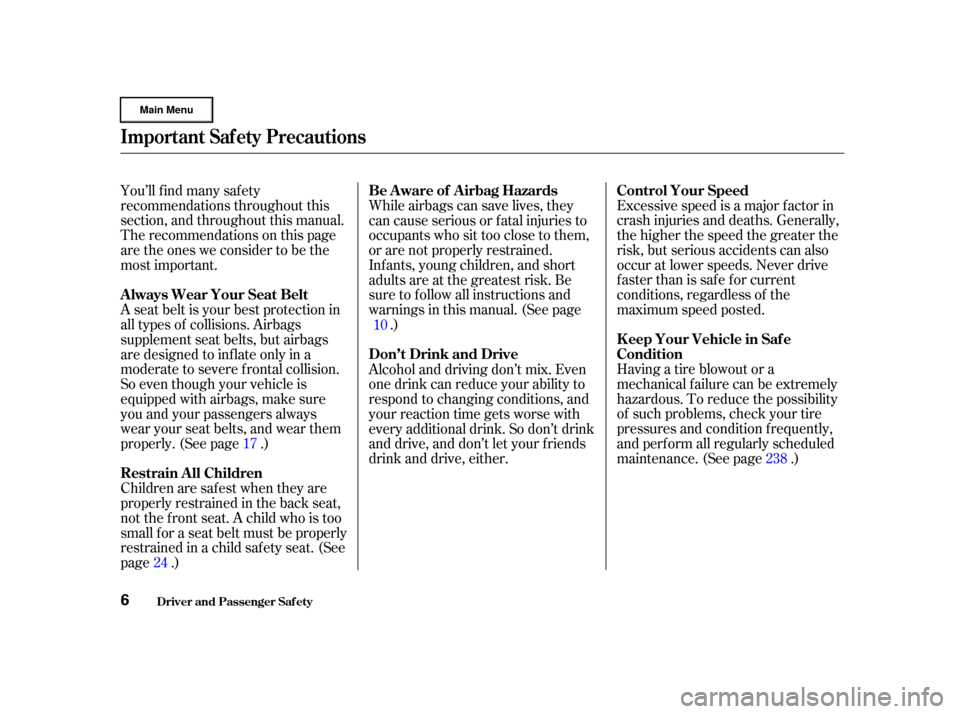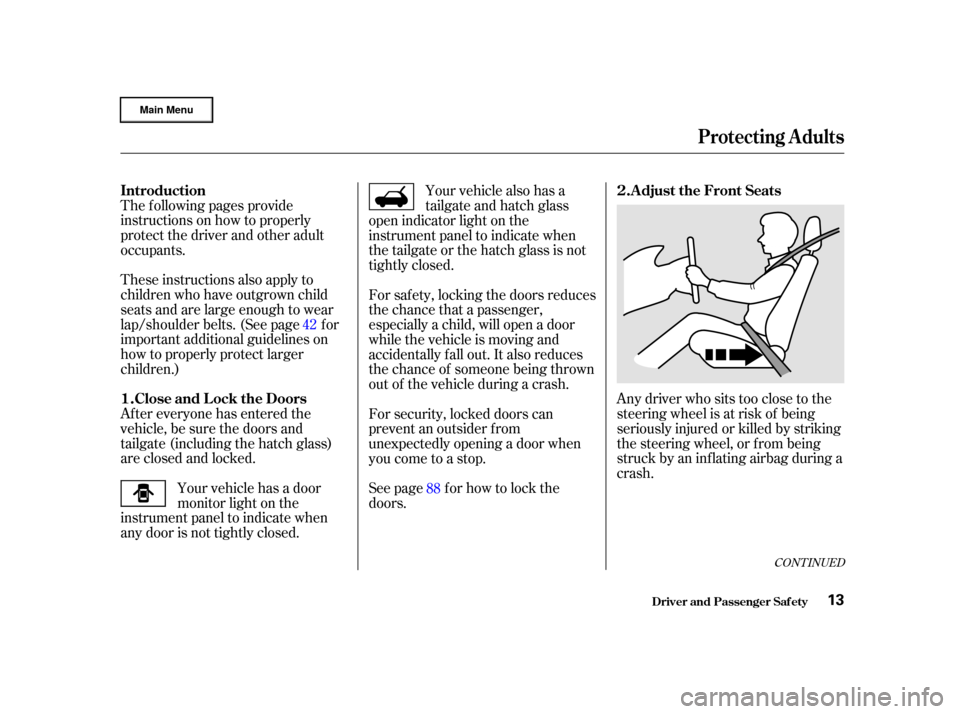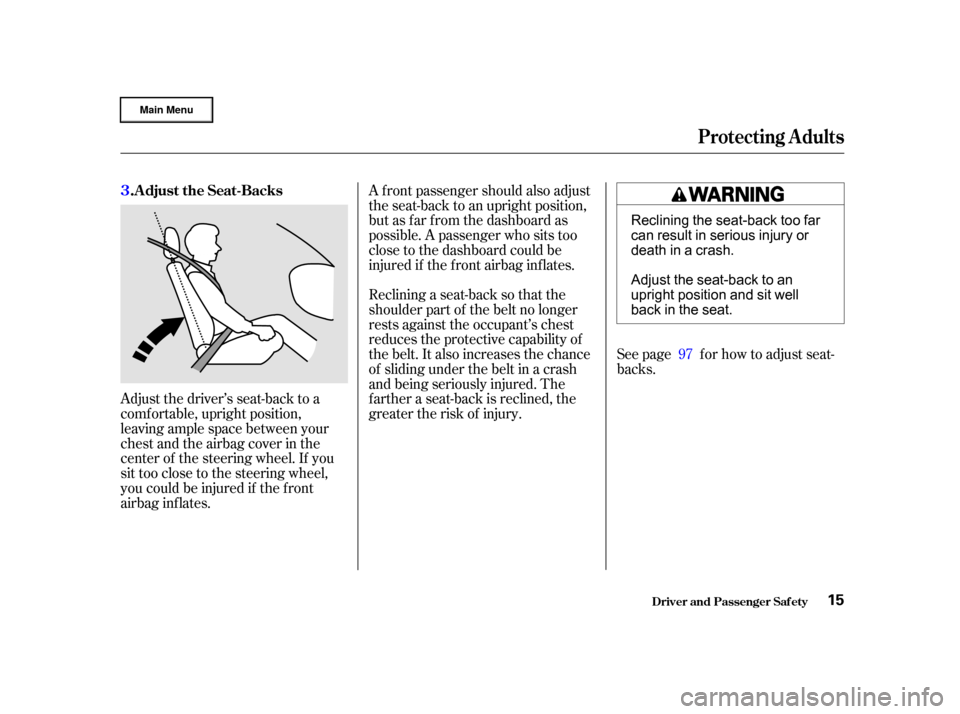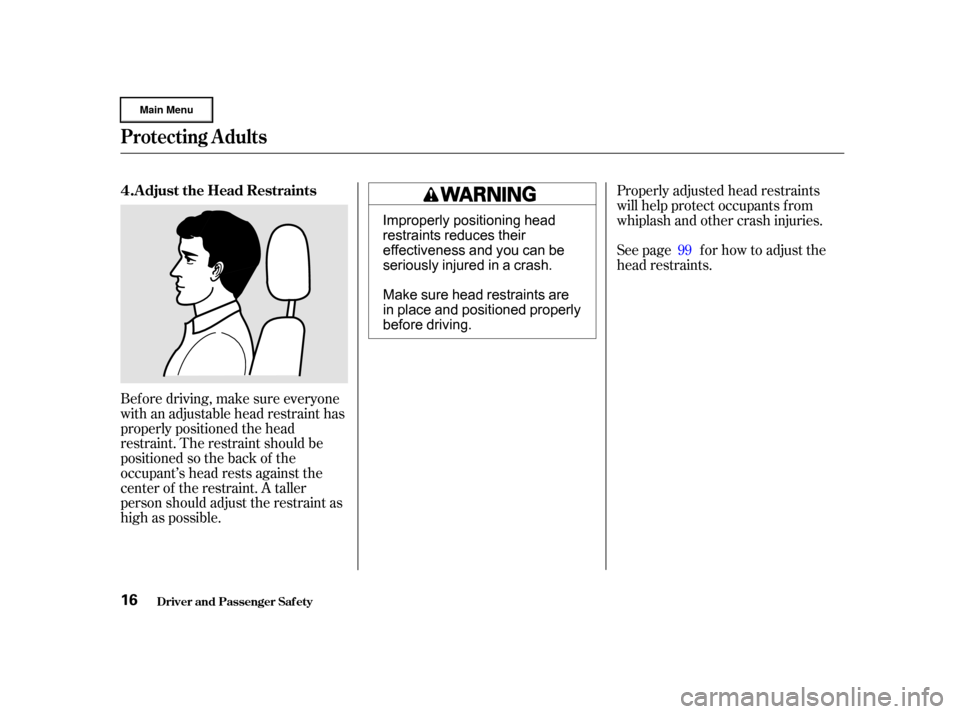VIN HONDA CR-V 2002 RD4-RD7 / 2.G Owners Manual
[x] Cancel search | Manufacturer: HONDA, Model Year: 2002, Model line: CR-V, Model: HONDA CR-V 2002 RD4-RD7 / 2.GPages: 372, PDF Size: 4.49 MB
Page 1 of 372

2002 CR-V Online Reference Owner's Manual
Use these links (and links throughout this manual) to navigate through this reference.
For a printed owner's manual, click on authorized manuals or go to www.helminc.com.
Contents
Owner's Identification Form
Introduction ........................................................................\
............................................................................. i
A Few Words About Safety ........................................................................\
.................................................. ii
Important Handling Information ........................................................................\
..................................... iii
Your Vehicle at a Glance ........................................................................\
....................................................... 2
Driver and Passenger Safety ........................................................................\
............................................... 5
Proper use and care of your vehicle's seat belts, and Supplemental Restraint System.
Instruments and Controls ........................................................................\
................................................... 63
Instrument panel indicator and gauge, and how to use dashboard and steering column controls.
Comfort and Convenience Features ........................................................................\
............................... 127
How to operate the climate control system, the audio system, and other convenience features.
Before Driving ........................................................................\
..................................................................... 183
What gasoline to use, how to break-in your new ve hicle, and how to load luggage and other cargo.
Driving ........................................................................\
................................................................................... 197
The proper way to start the engine, shift the tr ansmission, and park, plus towing a trailer.
Maintenance ........................................................................\
......................................................................... 233
The Maintenance Schedule shows you when you need to take your vehicle to the dealer.
Appearance Care ........................................................................\
................................................................. 297
Tips on cleaning and protecting your vehicle. Things to look for if your vehicle ever needs body repairs.
Taking Care of the Unexpected ........................................................................\
....................................... 307
This section covers several problems motorists someti mes experience, and how to handle them.
Technical Information ........................................................................\
....................................................... 339
ID numbers, dimensions, capaciti es, and technical information.
Warranty and Customer Relations (U.S. and Canada) ......................................................................353
A summary of the warranties covering your new Honda, and how to contact us.
Authorized Manuals (U.S. only) ........................................................................\
....................................... 357
How to order manuals and other technical literature.
Index ........................................................................\
......................................................................................... I
Service Information Summary
A summary of information you need wh en you pull up to the fuel pump.
Page 2 of 372

T his Owner’s Manual should be considered
a permanent part of the vehicle, and should
remain with the vehicle when it is sold.
T his Owner’s Manual covers all models of
the CR-V. You may f ind descriptions of
equipment and f eatures that are not on your
particular model.
T he inf ormation and specif ications included
in this publication were in ef f ect at the time
of approval f or printing. Honda Motor Co.,
Ltd. reserves the right, however, to
discontinue or change specif ications or
design at any time without notice and
without incurring any obligation whatsoever.
Owner’s Identif ication
Si pref iere este Manual del
Propietario en español,
comuníquese con el concesionario
Honda.
POUR CLIENTS CANADIEN
A VIS IMPORT A NT : Si vous avez
besoin d’un Manuel du Conduct eur
en f rançais, veuillez demander à
votreconcessionnairede
commander le numéro de pièce
33S9AC00
OWNER
ADDRESS
V. I. N.
DELIVERY DATE
DEALER NAMEDEALER NO.
ADDRESS
OWNER’S SIGNATURE
DEALER’S SIGNATURE
STREET
CITY STATE/PROVINCE ZIP CODE/
POSTAL CODE
(Date sold to original retail purchaser)
STREET
CITY STATE/PROVINCE ZIP CODE/
POSTAL CODE
Page 3 of 372

One of the best ways to enhance the enjoyment of your new Honda is to
read this manual. In it, you will learn how to operate its driving controls and
convenience items. Af terwards, keep this owner’s manual in your vehicle so
youcanrefertoitatanytime.
Several warranties protect your new Honda. Read the warranty booklet
thoroughly so you understand the coverages and are aware of your rights
and responsibilities.
Maintaining your vehicle according to the schedules given in this manual
helps to keep your driving trouble-f ree while it preserves your investment.
When your vehicle needs maintenance, keep in mind that your Honda
dealer’s staf f is specially trained in servicing the many systems unique to
your Honda. Your Honda dealer is dedicated to your satisf action and will be
pleased to answer any questions and concerns.As you read this manual, you will
f ind inf ormation that is preceded by
a
symbol. This
inf ormation is intended to help you
avoid damage to your Honda, other
property, or the environment.
Calif ornia Proposition 65 Warning This product contains or emits chemicals known to the State of
Calif ornia to cause cancer and birth def ects or other reproductive harm. Congratulations! Your selection of a 2002 Honda CR-V was a wise
investment. It will give you years of driving pleasure.
Introduction
WARNING:
i
Page 5 of 372

Your CR-V has higher ground clearance than a passenger vehicle designed f or use only on pavement. Higher ground
clearance has many advantages f or of f -highway driving. It allows you to travel over bumps, obstacles, and rough
terrain. It also provides good visibility so you can anticipate problems earlier.
These advantages come at some cost. Because your vehicle is taller and rides higher of f the ground, it has a high
center of gravity. This means your vehicle can tip or roll over if you make abrupt turns. Utility vehicles have a
signif icantly higher rollover rate than other types of vehicles. In a rollover crash, an unbelted person is signif icantly
more likely to die than a person wearing a seat belt. As a reminder, make sure you and your passengers always wear
seat belts.
For inf ormation on how to reduce the risk of rollover, read ‘‘Driving Guidelines’’ on page of this manual and thesection on page . Failure to operate this vehicle correctly may result in loss of control or an
accident. 226 198
Of f -Highway Guidelines
Important Handling Inf ormation
iii
Page 10 of 372

You’ll f ind many saf ety
recommendations throughout this
section, and throughout this manual.
Therecommendationsonthispage
are the ones we consider to be the
most important.Excessive speed is a major f actor in
crash injuries and deaths. Generally,
the higher the speed the greater the
risk, but serious accidents can also
occur at lower speeds. Never drive
f aster than is saf e f or current
conditions, regardless of the
maximum speed posted.
While airbags can save lives, they
can cause serious or fatal injuries to
occupants who sit too close to them,
or are not properly restrained.
Inf ants, young children, and short
adults are at the greatest risk. Be
sure to f ollow all instructions and
warnings in this manual. (See page
.)
Having a tire blowout or a
mechanical f ailure can be extremely
hazardous. To reduce the possibility
of such problems, check your tire
pressures and condition f requently,
and perform all regularly scheduled
maintenance. (See page .)
A seat belt is your best protection in
all types of collisions. Airbags
supplement seat belts, but airbags
are designed to inf late only in a
moderate to severe f rontal collision.
So even though your vehicle is
equipped with airbags, make sure
you and your passengers always
wear your seat belts, and wear them
properly. (See page .)
Children are saf est when they are
properly restrained in the back seat,
notthefrontseat.Achildwhoistoo
smallforaseatbeltmustbeproperly
restrained in a child saf ety seat. (See
page .) Alcohol and driving don’t mix. Even
one drink can reduce your ability to
respond to changing conditions, and
your reaction time gets worse with
every additional drink. So don’t drink
and drive, and don’t let your f riends
drink and drive, either.
17
238
24 10
Driver and Passenger Saf ety
Important Saf ety Precautions
Always Wear Your Seat Belt
Be Aware of Airbag Hazards Control Your Speed
K eep Your Vehicle in Saf e
Condition
Restrain All Children Don’t Drink and Drive
6
Page 12 of 372

These saf ety f eatures are designed
to reduce the severity of injuries in a
crash. However, you and your
passengers can’t take f ull advantage
of these saf ety f eatures unless you
remain sitting in a proper position
andIn f act, some saf ety
f eatures can contribute to injuries if
they are not used properly. Seat belts are the single most
effectivesafetydeviceforadultsand
larger children. (Inf ants and smaller
children must be properly restrained
in child seats.)
In addition, most states and all
Canadian provinces require you to
wear seat belts.
Foryoursafety,andthesafetyof
your passengers, your vehicle is
equipped with seat belts in all seating
positions.
Your seat belt system also
includes a light on the
instrument panel to remind you and
your passengers to f asten your seat
belts. Not wearing a seat belt properly
increases the chance of serious
injury or death in a crash, even
though your vehicle has airbags.
Driver and Passenger Saf ety
Seat Belts
always wear your seat belts
properly. Why Wear Seat Belt s
Your Vehicle’s Saf ety Features
8
Page 15 of 372

Your vehicle’s seats are designed to
keep you in a comf ortable, upright
position so you can take f ull
advantage of the protection offered
by seat belts and the energy
absorbing materials in the seats.Head restraints can help protect you
f rom whiplash and other injuries. For
maximum protection, the back of
your head should rest against the
center of the head restraint.
Reclining a seat-back too f ar reduces
the seat belt’s ef f ectiveness and
increases the chance that the seat’s
occupant will slide under the seat
belt in a crash and be seriously
injured. Move the f ront
seats as far back as possible, and
keep adjustable seat-backs in an
upright position whenever the
vehicle is moving. Keeping your doors locked reduces
thechanceof beingthrownoutof
the vehicle during a crash. It also
helps prevent occupants f rom
accidentally opening a door and
f alling out, and outsiders f rom
unexpectedly opening your doors.
How you adjust your seats and seat-
backs can also affect your safety. For
example, sitting too close to the
steering wheel or dashboard
increases the risk of you or your
passenger being injured by striking
theinsideof thevehicle,orbyan
inf lating airbag. Seats & Seat-Backs
Head RestraintsDoor L ocks
What you should do:
Your Vehicle’s Saf ety Features
Driver and Passenger Saf ety11
Page 17 of 372

The f ollowing pages provide
instructions on how to properly
protect the driver and other adult
occupants.
These instructions also apply to
children who have outgrown child
seats and are large enough to wear
lap/shoulder belts. (See page f or
important additional guidelines on
how to properly protect larger
children.)Any driver who sits too close to the
steering wheel is at risk of being
seriously injured or killed by striking
the steering wheel, or f rom being
struck by an inf lating airbag during a
crash.
Af ter everyone has entered the
vehicle, be sure the doors and
tailgate (including the hatch glass)
are closed and locked.
Your vehicle has a door
monitor light on the
instrument panel to indicate when
any door is not tightly closed. Your vehicle also has a
tailgate and hatch glass
open indicator light on the
instrument panel to indicate when
the tailgate or the hatch glass is not
tightly closed.
For saf ety, locking the doors reduces
the chance that a passenger,
especially a child, will open a door
while the vehicle is moving and
accidentally f all out. It also reduces
the chance of someone being thrown
out of the vehicle during a crash.
For security, locked doors can
prevent an outsider f rom
unexpectedly opening a door when
you come to a stop.
See page f or how to lock the
doors.
42
88
CONT INUED
Introduction
Close and L ock the Doors Adjust the Front Seats
1. 2.
Protecting Adults
Driver and Passenger Saf ety13
Page 19 of 372

See page f or how to adjust seat-
backs.
A f ront passenger should also adjust
the seat-back to an upright position,
but as f ar f rom the dashboard as
possible. A passenger who sits too
close to the dashboard could be
injured if the f ront airbag inf lates.
Reclining a seat-back so that the
shoulder part of the belt no longer
rests against the occupant’s chest
reduces the protective capability of
the belt. It also increases the chance
of sliding under the belt in a crash
and being seriously injured. The
farther a seat-back is reclined, the
greater the risk of injury.
Adjust the driver’s seat-back to a
comf ortable, upright position,
leaving ample space between your
chest and the airbag cover in the
center of the steering wheel. If you
sit too close to the steering wheel,
you could be injured if the f ront
airbag inflates. 97
Adjust the Seat-Backs
3.
Protecting Adults
Driver and Passenger Saf ety15
Reclining the seat-back too far
can result in serious injury or
death in a crash.
Adjust the seat-back to an
upright position and sit well
back in the seat.
Page 20 of 372

Bef ore driving, make sure everyone
with an adjustable head restraint has
properly positioned the head
restraint. The restraint should be
positioned so the back of the
occupant’s head rests against the
center of the restraint. A taller
person should adjust the restraint as
high as possible.Properly adjusted head restraints
will help protect occupants f rom
whiplash and other crash injuries.
See page f or how to adjust the
head restraints.
99
Driver and Passenger Saf ety
Protecting Adults
A djust the Head Restraints
4.
16
Improperly positioning head
restraints reduces their
effectiveness and you can be
seriously injured in a crash.
Make sure head restraints are
in place and positioned properly
before driving.